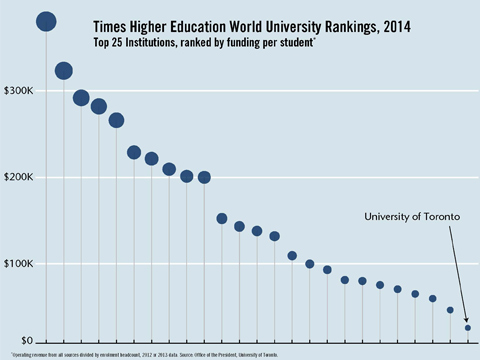Measured by major global university rankings, research productivity and impact, and the profile of our alumni, the University of Toronto is Canada’s leading university and one of the world’s best. We combine excellence with accessibility more successfully than virtually any university in the world.
Yet we achieve these results with funding per student that ranks among the lowest of any Canadian or American peer university. Ontario sits last among the provinces in per-student public support for universities. Compared with our public and private peers in the U.S., the difference is even more startling. The 19 universities ranked above us in the Times Higher Education World University Rankings benefit from operating funding per student on average seven times – and as much as 14 times – what is available to U of T. The five that placed just below us have on average more than three times per student what U of T has. Considering what this revenue is used for – student financial aid, recruiting and retaining top faculty, and providing excellent facilities – per-student funding is a matter of some consequence.
In light of these extreme financial challenges, U of T truly defies gravity. Without the incredible vision and generosity of many thousands of benefactors large and small, the university would have been in deep difficulty long ago. These alumni and friends will remain crucial to our continued success (including our ability to ensure access to all qualified students, regardless of their financial situation). But the government will remain an indispensible partner, too. This is as it should be, since everyone in Ontario benefits from a strong post-secondary education system. By providing advanced education to our next generation, universities build our capacity for innovation, and help ensure our shared economic and social prosperity. In fact, the social returns of higher education are substantial. Universities serve as crucial portals of opportunity – in Toronto especially, where so many people have come from other countries to contribute their talents and to build a better life.
As competition in the global knowledge economy intensifies, however, Canadian jurisdictions will need to invest more – or risk losing ground. Although U of T ranked 20th in the world (and first in Canada) again this year in the Times rankings, all other Canadian universities dropped, and McMaster University was the only other institution in Ontario to place in the top 100. This isn’t a matter of losing stature – it is a question of whether we can maintain and strengthen the culture of innovation on which our prosperity depends. To that end, governments around the world are investing heavily in post-secondary education. For example, since 1995, China has made massive investments, with the result that per-faculty research funding (at purchasing power parity) for China’s most globally competitive universities, the C9 group, has reached U.S. Ivy-League levels.

In Ontario, the provincial government deserves credit for making investments in post-secondary education to support enrolment growth in a time of fiscal restraint and economic uncertainty. And, through its differentiation policy, it has taken a major step toward enabling each institution to play to its strengths, thereby improving the system as a whole. If funding is allocated accordingly, taxpayers will receive greater value from existing per-student funding. At some point soon, though, we must face the reality that we need not only more efficient funding, but more funding full stop.
For a long time, provincial support was U of T’s largest source of operating revenue; by 2009, tuition fees overtook it. The province now provides a mere 32 per cent of the university’s annual operating revenues; tuition and other fees make up 55 per cent and other revenues, 13 per cent. Adjusted for inflation, per-student funding for Ontario universities has been declining since 1992.
Naturally, students and parents tend to focus on rising tuition fees, and their effect on accessibility. But there is a common misunderstanding that fees and accessibility are inversely related. In fact, since 2005, for every one dollar increase in tuition per domestic undergraduate at U of T, the university has increased its needs-based student aid by $1.07 per aid-receiving student. Thanks in part to generous donations from alumni, U of T is the Canadian leader in ensuring accessibility, providing some $165 million per year in student financial support. Nearly one half of our undergraduates receive financial aid. When you factor in grants from the Ontario Student Assistance Program, the Ontario Tuition Grant, and additional needs-based student aid from U of T, the actual tuition fees paid by these students amount to, on average, one half of the tuition “sticker price.” It’s worth emphasizing that financial aid from the programs mentioned above comes in the form of grants, not loans.
U of T and its sister institutions have long advocated for a higher per-student operating grant from Queen’s Park in order to sustain the quality of university education in Ontario. I admit it seems that any such increase is a long way off, especially while the province is running a budget deficit. Nevertheless, to continue to provide an excellent, accessible education, U of T, like all post-secondary institutions in Ontario, needs significantly increased funding per student. It’s important, therefore, that the government give universities the flexibility to use the resources they do have more efficiently, according to each institution’s strengths and priorities. Recent moves toward greater differentiation are a good start. The commitment to additional funds for deferred maintenance in the province’s 2014 budget is also welcome. And we look to the government at least to maintain its existing level of investment in the university sector. The hard work and brilliance of our faculty, staff and students, and the vital support of our alumni and friends, give us reason to hope that U of T will continue to defy gravity. We also hope that, when Ontario is in a position to increase its contribution, our partners at Queen’s Park will do so.
Sincerely,
Meric Gertler





